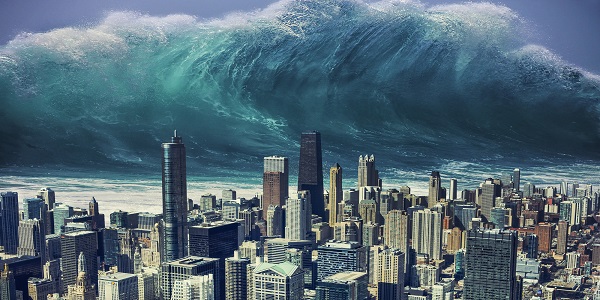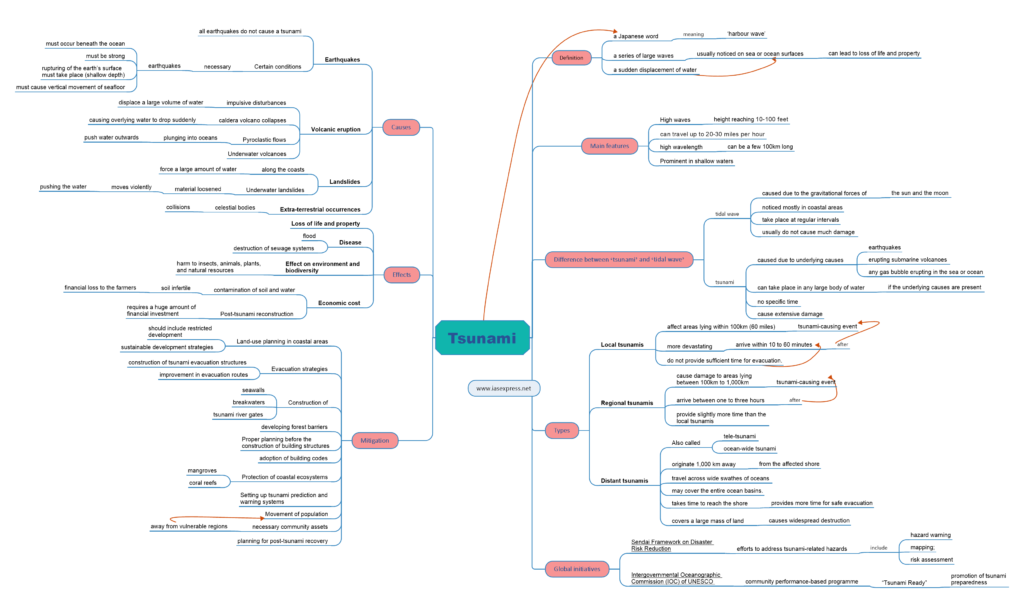Tsunami (Causes, Effects, and Mitigation)

Disasters have been wreaking havoc throughout human history. The wraths of the natural environment have been noticed time and again by all living organisms. Earthquakes, volcanic eruptions, droughts and floods are some of the well-known examples. A tsunami is one such natural disaster that is feared by human civilization the most. These enormous waves cause extensive and widespread destruction and unimaginable misery to habitats inhabited by human beings as well as various living organisms which has numerous short and long-term effects.

Tsunami – Definition
The word ‘tsunami’ is a Japanese word that stands for ‘harbour wave’. A tsunami is a series of large waves usually noticed on sea or ocean surfaces that can lead to a considerable amount of loss to life and property. It is a sudden displacement of water that can take place in any waterbody if underlying causes are present there.
Difference between ‘tsunami’ and ‘tidal wave’
- Tsunamis are usually referred to as ‘tidal waves’ but they are not so. There are a lot of differences between a tsunami and a tidal wave based on various factors:
- Cause
- A tidal wave is the caused due to the gravitational forces of the sun and the moon whereas tsunamis are caused due to underlying causes like earthquakes, erupting submarine volcanoes or any gas bubble erupting in the sea or ocean.
- Location
- Tidal waves are noticed mostly in coastal areas. On the contrary, tsunamis can take place in any large body of water if the underlying causes are present there.
- Frequency
- Tidal waves take place at regular intervals whereas a tsunami has no specific time and can occur at any time if there are favourable conditions (seismic activity) for its occurrence. However, tsunamis are rare.
- Intensity
- Tidal waves usually do not cause much damage if they are not very high and even if they are high, they can affect only coastal areas whereas a tsunami can travel a long distance and cause extensive damage.
Types
- Local tsunamis
- These affect areas lying within 100km (60 miles) of the tsunami-causing event (earthquake etc).
- These tsunamis can be more devastating because they arrive within 10 to 60 minutes of the occurrence of the tsunami-causing event.
- Such tsunamis do not provide sufficient time for evacuation.
- Regional tsunamis
- These tsunamis cause damage to areas lying between 100km to 1,000km from the tsunami-causing event. Sometimes, they may even harm areas lying outside the 1,000km perimeter.
- These tsunamis arrive between one to three hours after the occurrence of the tsunami-causing event.
- They provide slightly more time than the local tsunamis to take protective measures. However, one to three hours may not be sufficient enough for safe evacuation given a 1,000km area.
- Distant tsunamis
- Also called tele-tsunami or ocean-wide tsunami.
- They originate 1,000 km away from the affected shore.
- They travel across wide swathes of oceans and may cover the entire ocean basins.
- As it takes time to reach the shore, it provides more time for safe evacuation.
- It covers a large mass of land and thus causes widespread destruction.
Main features
- High waves with a height reaching 10-100 feet.
- They can travel up to 20-30 miles per hour.
- They have a high wavelength which can be a few 100km long.
- Prominent in shallow waters.
Causes
- Earthquakes
- The Earth’s surface is made up of tectonic plates and when these plates undergo any tectonic activity (spreading, subduction and transformation), they can lead to tsunamis.
- However, all earthquakes do not cause a tsunami. Certain conditions are necessary for an earthquake to cause a tsunami. Some of them are like earthquakes must occur beneath the ocean, it must be strong, rupturing of the earth’s surface must take place (shallow depth) and the earthquake must cause vertical movement of seafloor.
- Volcanic eruption
- Volcanic explosions cause impulsive disturbances and thus can displace a large volume of water generating extensive tsunamis.
- A tsunami can also take place if a caldera volcano collapses after an eruption causing overlying water to drop suddenly.
- Pyroclastic flows (dense mixtures of hot blocks, pumice, ash and gas) from volcanic slopes plunging into oceans can push water outwards leading to a tsunami.
- Underwater volcanoes can also cause a tsunami.
- However, such tsunamis are rare.
- Landslides
- Landslides occurring along the coasts can force a large amount of water into the sea thus causing a disturbance in water resulting in a tsunami.
- Underwater landslides also cause tsunami when the material loosened by the landslide moves violently, pushing the water in front of it.
- Extra-terrestrial occurrences
- A tsunami caused by extra-terrestrial collisions has not taken place in recent history but it is believed that if celestial bodies like asteroids or meteors strike the ocean, a large volume of water would be displaced causing a tsunami.
Effects
- Loss of life and property – Tsunamis can have devastating effects on life and property. This large displacement of water destroys housing and infrastructure in the areas affected by it. Many people lose their lives. Records say that since 1850, tsunamis have been responsible for the loss of more than 430,000 lives. Tsunamis cause collapsing of buildings, electrocution, gas leakage and explosions, damaging of tanks and floating of debris that further cause injury and death.
- Disease – Tsunami causes flood in the affected areas and destroy the basic infrastructure like the sewage systems. Flooding and contamination caused due to the destruction of sewage systems cause outbreaks of diseases, infections and illness thus causing more death.
- Effect on environment and biodiversity – Tsunamis not only affect human beings but also cause harm to insects, animals, plants, and natural resources. Plants are uprooted due to violent waves of a tsunami, nesting sites are destroyed, land animals get killed by drowning and marine life is harmed by the flow of toxic chemicals into the waterbody. Solid waste and disaster debris are other critical environmental problems faced by a disaster-hit area.
- Economic cost – Tsunami causes contamination of soil and water. It increases the salinity of the soil. The mixing up of disaster debris with the soil and high salinity makes the soil infertile and unfit for cultivation thus adding to financial loss to the farmers and raising the chances of food insecurity.
- Post-tsunami reconstruction also requires a huge amount of financial investment. Thus, tsunami has a huge economic cost for an economy.
Mitigation
Mitigation strategies may help lower the effect of damages and destructions caused by a tsunami.
Some of them are: –
- Land-use planning in coastal areas should include restricted development and sustainable development strategies.
- Evacuation strategies should include the construction of tsunami evacuation structures and improvement in evacuation routes.
- Construction of seawalls, breakwaters, tsunami river gates and developing forest barriers may also help in preventing extensive damage.
- Proper planning before the construction of building structures and the adoption of building codes should be done to prevent damage to life and property.
- Protection of coastal ecosystems like mangroves and coral reefs may help in lowering tsunami-related hazards.
- Setting up tsunami prediction and warning systems.
- Movement of population and necessary community assets away from vulnerable regions and planning for post-tsunami recovery should be done.
Global initiatives
- The Sendai Framework on Disaster Risk Reduction adopted in 2015 has put forward the following efforts to address tsunami-related hazards. These include
- hazard warning;
- mapping; and
- risk assessment.
- The Intergovernmental Oceanographic Commission (IOC) of UNESCO has started a community performance-based programme known as “Tsunami Ready” for the promotion of tsunami preparedness by actively involving the public, community leaders, and national and local emergency management agencies.
Conclusion
Globally, more than 700 million people live in low-lying coastal areas and Small Island Developing States and they are at high risk of extreme sea-level events including tsunamis. To address such a natural hazard, a comprehensive approach is required. Efforts have been taken in this direction yet more efforts are required to protect more people from loss of life and property. Building resilient infrastructure, setting up early warning systems, and spreading awareness among people is critical in preventing tsunami-related risks in the future.
If you like this post, please share your feedback in the comments section below so that we will upload more posts like this.


Very nice